"How many colors are there in a field of grass to the crawling baby unaware of 'Green'? How many rainbows can light create for the untutored eye? How aware of variations in heat waves can that eye be? Imagine a world alive with incomprehensible objects and shimmering with an endless variety of movement and innumerable gradations of color."
~ Stan Brakhage, Metaphors on Vision (1963)
22 March 2008
20 March 2008
Spring

Kees van Dongen, "Spring" (1908); oil on canvas, 32" x 40"
Click on image to see larger version in a new window.
Happy Equinox: 20 March 2008.
14 March 2008
13 March 2008
Oscar Wilde: "Study in Green"
"In a very ugly and sensible age, the arts borrow, not from life, but from each other."
~ Oscar Wilde, from "Pen, Pencil and Poison: A Study in Green" (originally in Fortnightly Review, January 1889)
This magazine article recounting the life of the murderous artist and writer Thomas Griffiths Wainewright (1794-1847) is also the source of at least two other bons mots from the famously quotable Oscar Wilde:
~ Oscar Wilde, from "Pen, Pencil and Poison: A Study in Green" (originally in Fortnightly Review, January 1889)
This magazine article recounting the life of the murderous artist and writer Thomas Griffiths Wainewright (1794-1847) is also the source of at least two other bons mots from the famously quotable Oscar Wilde:
- "A mask tells us more than a face."
- "All beautiful things belong to the same age."
12 March 2008
What's Important

Giacomo Balla, "Abstract Speed: The Car Has Passed" (1913); oil on canvas
"In a way, art is a theory about the way the world looks to human beings. It's abundantly obvious that one doesn't know the world around us in detail. What artists have accomplished is realizing that there's only a small amount of stuff that's important, and then seeing what it was."
~ mathematical physicist Mitchell Feigenbaum, as quoted by James Gleick in Chaos: Making a New Science (1988)
11 March 2008
Patterns

"According to Fertility Hollis, there is no chaos. There are only patterns, patterns on top of patterns, patterns that affect other patterns. Patterns hidden by patterns. Patterns within patterns. If you watch close, history does nothing but repeat itself. What we call chaos is just patterns we haven't recognized. What we call random is just patterns we can't decipher. What we can't understand we call nonsense. What we can't read we call gibberish.”
~ Chuck Palahniuk, Survivor
Photo by Helquin.
10 March 2008
Crisis of Modernism
As a follow-up to yesterday's post about Vitaly Komar, here's a little something from his former Sots Art collaborator Alex Melamid:
Holy Hip-Hop! New Paintings by Alex Melamid
[at the Museum of Contemporary Art Detroit]
"This is the crisis of modernism. Modern art used to reflect a radical way of thinking. It did this until World War II and then it gradually became more and more established. Eventually, the radical thinking was totally removed from this. People adapted to this, said O.K. let there be, say, triangles. But in the beginning painting triangles was a huge statement, a daredevil act -- for good or for worse that's a different story, but that's how it was. But now it's totally changed its meaning because it's just a bourgeois business. You produce pictures and you sell them. You keep the form -- you can play with triangles endlessly -- but the meaning is lost, so it's a perversion of the intention of modernism. And nobody cares. The same thing happened with academic painting and ancient history. Nobody believed in it anymore, nobody cared, but still they went on depicting these beautiful women, these mythological figures. But it was totally obsolete. It lost the common sense; it lost touch with the people. Modernism was the idea to get back to some sense. Now it is senseless, so we have to revise again."Bonus Link:
~ Alex Melamid, from an interview in The Nation, 14 March 1994
Holy Hip-Hop! New Paintings by Alex Melamid
[at the Museum of Contemporary Art Detroit]
09 March 2008
Entertainment + Questions
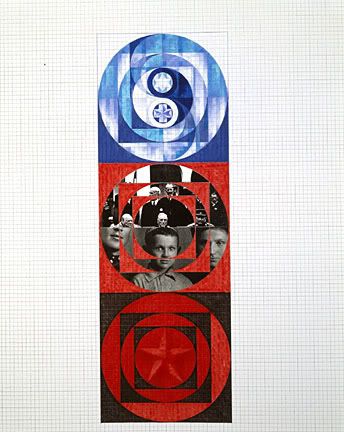
Vitaly Komar, "Big Red Moustache," from Three-Day Weekend
(2004-05); mixed media on paper, 40" x 30"
"Of course some art is entertaining, looks like entertainment, but the most important thing is to bring the questions in people's minds. If art is entertainment which raises new questions, I'm for that. But if art just answers questions, it's nothing but propaganda."
~ Vitaly Komar (b. 1943)
Links:
- Three-Day Weekend
- Three-Day Weekend reviewed by Donald Goddard
- Three-Day Weekend at Idlehacker
- Sots Art (Soviet Pop)
- Vitaly Komar and Alex Melamid
- Painting by Numbers: Komar and Melamid's scientific guide to art
- Komar & Melamid: The Most Wanted Paintings (a hoot: bring on the blue landscapes!)
08 March 2008
Connecting
"I'm interested in reconstructing symbols. It's about connecting with an older knowledge and trying to discover continuities in why we search for heaven."
~ Anselm Kiefer (born 8 March 1945)
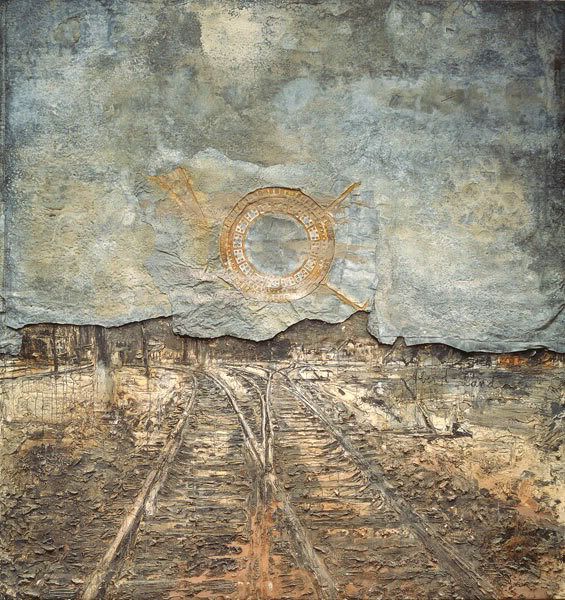
Anselm Kiefer, "Abendland (Twilight of the West)" (1989);
synthetic polymer paint, ash, plaster, cement, earth, varnish
on canvas and wood, approx. 13' 2" x 12' 6"
Click on image to see larger version in a new window.
~ Anselm Kiefer (born 8 March 1945)

Anselm Kiefer, "Abendland (Twilight of the West)" (1989);
synthetic polymer paint, ash, plaster, cement, earth, varnish
on canvas and wood, approx. 13' 2" x 12' 6"
Click on image to see larger version in a new window.
- Anselm Kiefer at White Cube
- Anselm Kiefer: Heaven and Earth
- Anselm Kiefer: Works on Paper 1969-1993
07 March 2008
Plan B
Brainstorm
"A creator, such as an artist, musician, photographer, craftsperson, performer, animator, designer, videomaker, or author -- in other words, anyone producing works of art -- needs to acquire only 1,000 True Fans to make a living."
~ Kevin Kelly, "1,000 True Fans"
Bypass
BugMeNot: break through the online password-protection barrier.
Bad Words
[from Douglas Harper's Online Etymology Dictionary]
Part One:
"Probably the most common American vulgarity from about the middle of the eighteenth century to the middle of the twentieth" [Rawson]. Abbreviated form SOB from 1918. Mencken, complaining of the tepidity of the American vocabulary of profanity, writes that the toned-down form son-of-a-gun "is so lacking in punch that the Italians among us have borrowed it as a satirical name for an American: la sanemagogna is what they call him, and by it they indicate their contempt for his backwardness in the art that is one of their great glories." [The American Language, 4th ed., p.317-8]
Part Two:
"The T-word occupies a special niche in literary history, however, thanks to a horrible mistake by Robert Browning, who included it in 'Pippa Passes' (1841) without knowing its true meaning. 'The owls and bats,/Cowls and twats,/Monks and nuns,/In a cloister's moods.' Poor Robert! He had been misled into thinking the word meant 'hat' by its appearance in 'Vanity of Vanities,' a poem of 1660, containing the treacherous lines: 'They'd talk't of his having a Cardinalls Hat,/They'd send him as soon an Old Nuns Twat.' (There is a lesson here about not using words unless one is very sure of their meaning.)" [Hugh Rawson, Wicked Words, 1989]
Further details of Browning's error at Language Log.
Bizarre
Truck Spills: "The website of odd, strange, interesting, and unbelievable things spilled on the road by trucks." Don't miss the exploding whale.
"A creator, such as an artist, musician, photographer, craftsperson, performer, animator, designer, videomaker, or author -- in other words, anyone producing works of art -- needs to acquire only 1,000 True Fans to make a living."
~ Kevin Kelly, "1,000 True Fans"
Bypass
BugMeNot: break through the online password-protection barrier.
Bad Words
[from Douglas Harper's Online Etymology Dictionary]
Part One:
"Probably the most common American vulgarity from about the middle of the eighteenth century to the middle of the twentieth" [Rawson]. Abbreviated form SOB from 1918. Mencken, complaining of the tepidity of the American vocabulary of profanity, writes that the toned-down form son-of-a-gun "is so lacking in punch that the Italians among us have borrowed it as a satirical name for an American: la sanemagogna is what they call him, and by it they indicate their contempt for his backwardness in the art that is one of their great glories." [The American Language, 4th ed., p.317-8]
Part Two:
"The T-word occupies a special niche in literary history, however, thanks to a horrible mistake by Robert Browning, who included it in 'Pippa Passes' (1841) without knowing its true meaning. 'The owls and bats,/Cowls and twats,/Monks and nuns,/In a cloister's moods.' Poor Robert! He had been misled into thinking the word meant 'hat' by its appearance in 'Vanity of Vanities,' a poem of 1660, containing the treacherous lines: 'They'd talk't of his having a Cardinalls Hat,/They'd send him as soon an Old Nuns Twat.' (There is a lesson here about not using words unless one is very sure of their meaning.)" [Hugh Rawson, Wicked Words, 1989]
Further details of Browning's error at Language Log.
Bizarre
Truck Spills: "The website of odd, strange, interesting, and unbelievable things spilled on the road by trucks." Don't miss the exploding whale.
06 March 2008
The Blank Page Is Not Blank
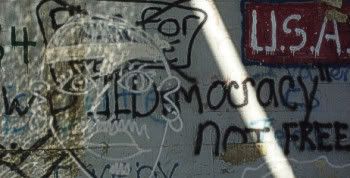
PALIMPSEST:
But it is not true that "nothing is given": Language comes not only with an infinite potential for new combinations, but with a long history contained in it.~ Rosmarie Waldrop, "Palimpsest," from "Thinking of Follows," in Onward: Contemporary Poetry and Poetics
The blank page is not blank. No text has one single author. Whether we are conscious of it or not, we always write on top of a palimpsest (cf. Duncan's "grand collage").
This is not a question of linear "influence," but of writing as dialog with a whole net of previous and concurrent texts, tradition, with the culture and language we breathe and move in, which conditions us even while we help to construct it.
Many of us have foregrounded this awareness as technique: using, collaging, transforming, "translating" parts of other works.
Link:
Rosmarie Waldrop at the Electronic Poetry Center

Photos by Helquin.
05 March 2008
Business is Business
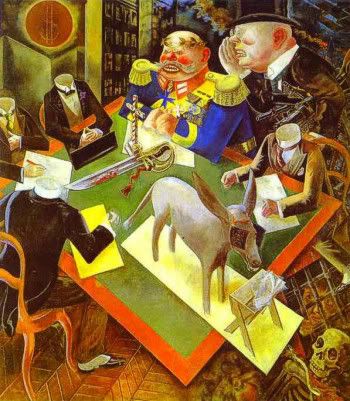
George Grosz, "Eclipse of Sun" (1926); oil on canvas, approx. 82.5" x 72.5"
Click on image to see larger version in a new window.
"The cult of individuality and personality, which promotes painters and poets only to promote itself, is really a business. The greater the 'genius' of the personage, the greater the profit."
~ George Grosz (1893-1959)
Link:
George Grosz at MoMA
04 March 2008
Wards and Cells
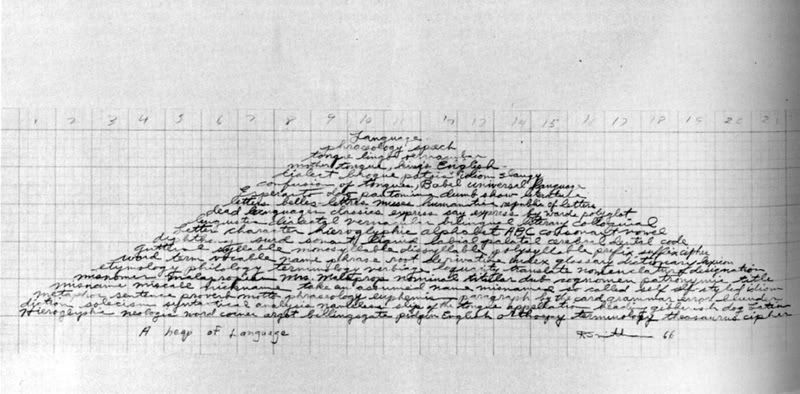
Robert Smithson, "A Heap of Language" (1966); pencil on paper, 6.5" x 22"
Click on image to see larger version in a new window.
"Artists themselves are not confined, but their output is. Museums, like asylums and jails, have wards and cells -- in other words, neutral rooms called 'galleries.' A work of art when placed in a gallery loses its charge, and becomes a portable object or surface disengaged from the outside world."
~ Robert Smithson (1938-1973), from "Cultural Confinement"
Link:
Robert Smithson website
03 March 2008
The Memory of Time
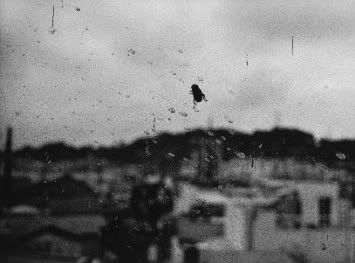
Daido Moriyama, "Fly, Suwa City, Nagano" (1982); gelatin silver print, 14" x 17"
"A photograph is the result of a momentary thought, with the result that you are always experimenting and interpreting the streets and buildings of a city by using the reproduction equipment -- the camera -- in order to get beyond known languages and to develop another reality running counter to the incessant flow of time. If this is achieved, the image captured in the photograph transcends the limited imagination or the ego of the photographer and becomes a symbol that signifies a world and includes the memory of time."
~ Daido Moriyama (b. 1938)
Link:
Daido Moriyama at Tepper Takayama Fine Arts
02 March 2008
Questions
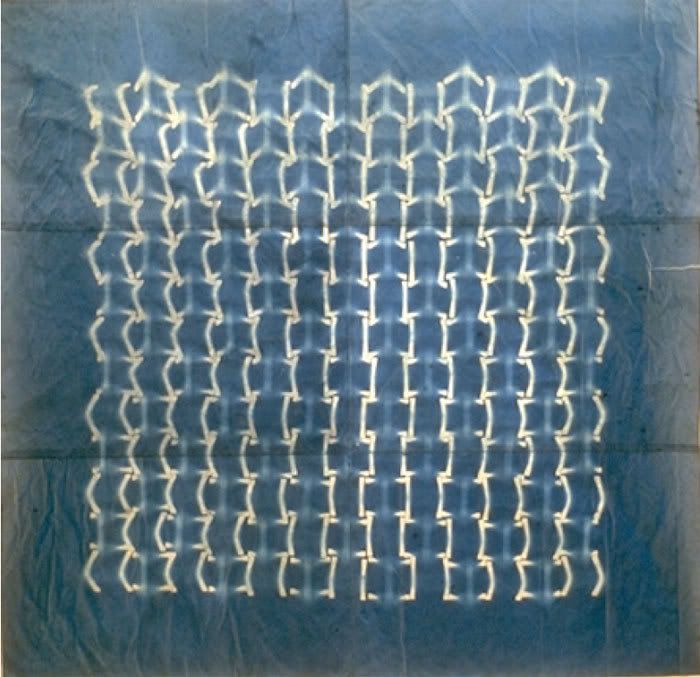
Robin Hill, "place sawhorses on paper. expose to light. wait."
(1997); cyanotype on paper, 60" x 60"
Click on image to see larger version in a new window.
"I think the way artists talk about their work says a lot about how they think as artists. It doesn't really matter whether or not they're good public speakers. That's not the issue. What's interesting is whether they talk only about their most recent work. Do they talk about it chronologically? Do they talk about their work thematically? Do they separate the drawings from the painting and the sculpture? How an artist goes about structuring a presentation tells you so much about the work itself. I think it's important to give your public an opportunity to see what you're struggling with and what you're trying to define for yourself, what questions you are asking yourself."
~ Robin Hill, in an interview with Ron Janowich, published in Other Voices (May 2007)
Link:
Robin Hill website
01 March 2008
Penetrate the Mystery
"Any serious exploration of occult, surrealistic, phantasmagoric gifts and phenomena presupposes a dialectical intertwinement to which a romantic turn of mind is impervious. For histrionic or fanatical stress on the mysterious side of the mysterious takes us no further; we penetrate the mystery only to the degree that we recognize it in the everyday world, by virtue of a dialectical optic that perceives the everyday as impenetrable, the impenetrable as everyday. The most passionate investigation of telepathic phenomena, for example, will not teach us half as much about reading (which is an eminently telepathic process), as the profane illumination of reading about telepathic phenomena. And the most passionate investigation of the hashish trance will not teach us half as much about thinking (which is eminently narcotic), as the profane illumination of thinking about the hashish trance. The reader, the thinker, the loiterer, the flâneur, are types of illuminati just as much as the opium eater, the dreamer, the ecstatic. [And more profane. Not to mention that most terrible drug --ourselves -- which we take in solitude.]"
~ Walter Benjamin, from "Surrealism" (1927), in Selected Writings, vol. 2
[First encountered (in part) in "Draft 85: Hard Copy by Rachel Blau DuPlessis, via wood s lot.]
About the flâneur:
Flâneur.org's Flanifesto
Walter Benjamin's descriptions
~ Walter Benjamin, from "Surrealism" (1927), in Selected Writings, vol. 2
[First encountered (in part) in "Draft 85: Hard Copy by Rachel Blau DuPlessis, via wood s lot.]
About the flâneur:
"There is no English equivalent for the French word flâneur. Cassell's dictionary defines flâneur as a stroller, saunterer, drifter but none of these terms seems quite accurate. There is no English equivalent for the term, just as there is no Anglo-Saxon counterpart of that essentially Gallic individual, the deliberately aimless pedestrian, unencumbered by any obligation or sense of urgency, who, being French and therefore frugal, wastes nothing, including his time which he spends with the leisurely discrimination of a gourmet, savoring the multiple flavors of his city."Wikipedia article
~ Cornelia Otis Skinner, Elegant Wits and Grand Horizontals
Flâneur.org's Flanifesto
Walter Benjamin's descriptions
Subscribe to:
Posts (Atom)
